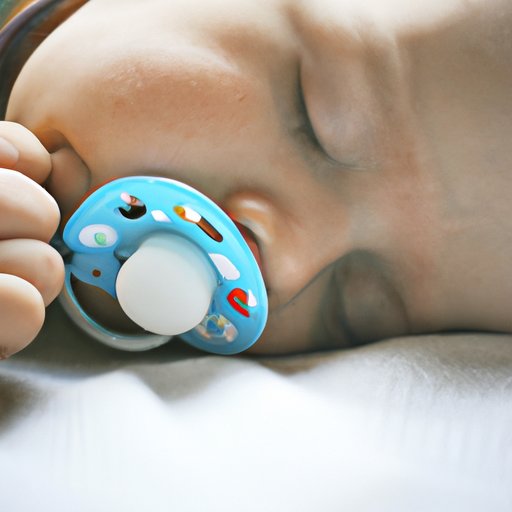Introduction
Babies often rely on pacifiers to comfort themselves during sleep. However, at some point, it is necessary to wean your baby off the pacifier and move them toward other methods of self-soothing. This article will provide an overview of when to consider removing the pacifier from your baby’s sleeping routine, as well as strategies for helping your baby transition away from the pacifier.
How to Tell When It’s Time to Take Away Your Baby’s Pacifier
The American Academy of Pediatrics recommends that parents avoid using pacifiers with babies under six months old, as it can interfere with breastfeeding. After six months, the AAP suggests that parents start to consider whether or not it is time to take away the pacifier. To decide if it is time, look for the following signs:
- Your baby is over two years old.
- Your baby is having difficulty eating or drinking due to the pacifier.
- Your baby is having trouble speaking clearly due to the pacifier.
- Your baby is having dental problems due to the pacifier.
If you notice any of these signs, it may be time to start considering taking away your baby’s pacifier. Discussing the issue with your pediatrician can also help you determine if it is time to wean your baby off the pacifier.

Understanding the Pros and Cons of Keeping a Pacifier at Bedtime
Using a pacifier to help your baby fall asleep has both benefits and drawbacks. On one hand, pacifiers can be very helpful in soothing babies and helping them fall asleep. Some studies have even found that babies who use pacifiers are less likely to die of sudden infant death syndrome (SIDS). On the other hand, there are potential drawbacks to pacifier use, such as increased ear infections and dental problems.
Tips for Weaning Your Baby off a Pacifier
If you decide it is time to wean your baby off the pacifier, there are several tips that can make the process easier. The first is to gradually decrease pacifier use. Start by limiting pacifier use to nighttime only, then gradually reduce the amount of time your baby uses the pacifier until they are no longer using it. You can also introduce a transitional object, such as a stuffed animal or blanket, to help your baby feel comforted without the pacifier. Finally, you can replace the pacifier with a comforting routine, such as reading a book or singing a song before bed.

Strategies for Helping Your Baby Sleep Without a Pacifier
Once you have successfully weaned your baby off the pacifier, there are several strategies you can employ to help them sleep without it. Establishing a consistent bedtime routine can help your baby learn to relax and fall asleep without the pacifier. Adjusting the environment to promote better sleep, such as making sure the room is dark and quiet, can also help. Additionally, responding to nighttime awakenings appropriately, such as providing reassurance but not picking up the baby, can help them learn to self-soothe and fall back asleep without the pacifier.

Establishing a Safe Age Limit on Pacifier Use
It is important to establish a safe age limit for pacifier use. Prolonged pacifier use can lead to dental problems and speech issues. Therefore, it is important to set a limit for when your child should stop using a pacifier. A good rule of thumb is to limit pacifier use to no later than age three. However, this is just a general guideline, and it is best to discuss the issue with your pediatrician to determine the best age limit for your child.
Preparing Your Baby for Pacifier Detachment
Preparing your baby emotionally for the transition away from the pacifier is key to making the switch as smooth as possible. Talk to your baby about the change and explain why they need to give up their pacifier. You can also try giving your baby a “pacifier fairy” or “pacifier monster” to help them understand that the pacifier is gone. Finally, it is important to be patient and understanding during the transition, as it can be difficult for babies to give up something that has been a source of comfort for so long.
Conclusion
Deciding when to take away your baby’s pacifier can be a difficult decision. It is important to consider the potential benefits and drawbacks of pacifier use and discuss the issue with your pediatrician. Once you have decided it is time to take away the pacifier, there are several strategies that can help make the transition smoother, such as gradually reducing pacifier use, introducing a transitional object, and establishing a consistent bedtime routine. With patience and understanding, you can help your baby transition away from the pacifier and develop healthy sleep habits.


